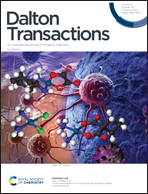Modifying the internal substituents of self-assembled cages controls their molecular recognition and optical properties†
Abstract
Self-assembled Fe4L6 cage complexes with variable internal functions can be synthesized from a 2,7-dibromocarbazole ligand scaffold, which orients six functional groups to the cage interior. Both ethylthiomethylether and ethyldimethylamino groups can be incorporated. The cages show strong ligand-centered fluorescence emission and a broad range of guest binding properties. Coencapsulation of neutral organic guests is favored in the larger, unfunctionalized cage cavity, whereas the thioether cage has a more sterically hindered cavity that favors 1 : 1 guest binding. Binding affinities up to 106 M−1 in CH3CN are seen. The dimethylamino cage is more complex, as the internal amines display partial protonation and can be deprotonated by amine bases. This amine cage displays affinity for a broad range of neutral organic substrates, with affinities and stoichiometries comparable to that of the similarly sized thioether cage. These species show that simple variations in ligand backbone allow variations in the number and type of functions that can be displayed towards the cavity of self-assembled hosts, which will have applications in biomimetic sensing, catalysis and molecular recognition.



 Please wait while we load your content...
Please wait while we load your content...